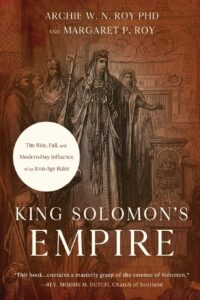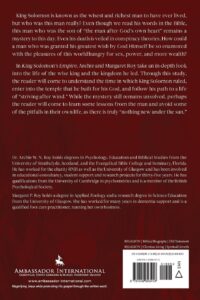In the dimly lit corners of occult bookshops and across the digital shelves of esoteric websites, you’ll find countless references to the “magical practices of King Solomon.” These texts promise ancient wisdom from the biblical monarch—elaborate rituals for commanding demons, complicated angel hierarchies, and magical operations tied to planetary hours and days of the week. The Lesser Key of Solomon, the Greater Key of Solomon, the Testament of Solomon—these grimoires have captured the imagination of magical practitioners for centuries.
But there’s a historical problem hiding in plain sight: much of what these texts contain would have been completely foreign to the historical Solomon himself. Let’s embark on a journey through time to separate the historical practices of Solomon’s era from the medieval fantasies that bear his name.

The Historical Solomon: A 10th Century BCE King
King Solomon traditionally ruled the United Kingdom of Israel around 970-931 BCE. This places him firmly in the Iron Age, in a world dominated by regional powers like Egypt and emerging Assyria, long before the Persian, Greek, or Roman empires that would later reshape the magical and religious landscape of the Mediterranean world.
Archaeological Insights into Solomon’s World
Archaeological excavations across ancient Israel have revealed much about the religious practices of this period. The material culture shows a religious landscape far different from what later magical texts would suggest:
- Material remains: Archaeological digs consistently uncover household shrines with multiple deity figurines (called teraphim), suggesting that despite the biblical emphasis on monotheism, many Israelites practiced forms of polytheistic worship.
- Inscriptions: Early Hebrew inscriptions make no mention of elaborate angel hierarchies or the kinds of demonology found in later magical texts.
- Religious centers: Evidence of high places (bamot) and local shrines shows decentralized worship practices alongside the Jerusalem Temple cult.
Dr. Sarah Nakhai, professor of Near Eastern archaeology, notes: “The archaeological record strongly suggests that religious practices during the 10th century BCE in Israel were fluid, incorporating elements from surrounding Canaanite culture and bearing little resemblance to the systematic magical operations attributed to Solomon in medieval grimoires.”
Actual Magical Practices of Solomon’s Era
What did magic and ritual actually look like in Solomon’s time? Archaeological and textual evidence suggests:
- Protective amulets: Simple inscribed stones or metal pieces with basic invocations for protection from evil forces.
- Divination practices: Including the use of Urim and Thummim (mentioned in the Bible), possibly stones used for yes/no divination questions.
- Healing rituals: Combining herbal remedies with prayer and incantations, as evidenced by medical-magical texts from neighboring cultures.
- Apotropaic practices: Door markings and symbols on pottery to ward off evil spirits.
- Weather magic: Rituals aimed at ensuring rainfall—critical in an agrarian society dependent on seasonal precipitation.
- Cleromancy: The casting of lots to determine divine will or make decisions.
These practices were pragmatic, relatively simple, and integrated into everyday life. They did not involve the elaborate ceremonial magic, spirit catalogues, or cosmological frameworks found in later Solomonic grimoires.
The Legendary Solomon: From King to Mythical Magician
So how did Solomon, a king primarily noted in biblical accounts for his wisdom and Temple-building, transform into history’s greatest magician? The evolution of this legend provides fascinating insights into how cultural transmission reshapes historical figures:
The Biblical Foundation
The seeds for Solomon’s magical reputation can be found in sparse biblical references:
- In 1 Kings 4:33, Solomon is described as having knowledge of plants and animals, which later traditions expanded into mastery of herbal magic.
- His legendary wisdom, including the ability to resolve difficult disputes (like the famous case of two women claiming the same baby), was later interpreted as supernatural discernment.
- His political and trade connections with distant lands like Sheba were recast as relationships with exotic magical knowledge sources.
The Hellenistic Transformation
The most significant expansion of Solomon’s magical reputation occurred during the Hellenistic period (323-30 BCE), when Jewish culture increasingly interacted with Greek thought:
- Testament of Solomon: This pseudepigraphical text (likely composed between 1st century BCE and 3rd century CE) transformed Solomon into a master of demons who used a magical ring to command spirits to build the Temple.
- Jewish-Hellenistic synthesis: Greek magical papyri began incorporating “Solomon” as a power name in spells, blending Jewish and Greek magical traditions.
- Josephus’ account: The Jewish historian Flavius Josephus (1st century CE) described Solomon as an exorcist and the author of magical incantations, cementing this reputation in historical writing.
Medieval Elaboration
By the medieval period, Solomon’s reputation as a magician had fully flowered:
- Islamic influences: In Arabic traditions, Solomon (Sulayman) commanded the jinn with his magical ring or seal, adding new elements to the evolving legend.
- Kabbalistic developments: Jewish mystical traditions elaborated on Solomon’s knowledge of divine names and their powers.
- Christian demonology: Medieval Christian scholars developed elaborate hierarchies of demons, retroactively attributing this knowledge to Solomon.
The Grimoires: Medieval Fantasies with Ancient Branding
The famous grimoires attributed to Solomon—like the Lesser Key (Lemegeton) and the Greater Key (Clavicula Salomonis)—were actually compiled much later, primarily during the Renaissance and early modern periods (15th-17th centuries).
Historical Anachronisms Reveal the Truth
The books contain numerous historical anachronisms that reveal their true origins:
- Planetary week: As you astutely observed, the seven-day week with planetary associations (Sunday/Sun, Monday/Moon, etc.) developed during the Roman Empire, nearly a millennium after Solomon.
- Medieval cosmology: The grimoires describe a universe structured according to Ptolemaic cosmology, unknown during Solomon’s era.
- Christian elements: Invocations often include explicitly Christian formulations, including Trinitarian concepts completely foreign to Solomon’s Judaism.
- Later languages: Many spirit names show Latin, Greek, or Arabic linguistic influences that only affected the Levant centuries after Solomon’s death.
- Medieval social structures: The hierarchies of spirits often mirror medieval feudal hierarchies, with kings, dukes, and marquises—social titles meaningless in Solomon’s time.
Dr. Joseph Peterson, a historian of magical texts, explains: “The Solomonic grimoires represent primarily medieval and Renaissance magical traditions dressed in biblical authority. Attributing these texts to Solomon gave them tremendous cultural weight in societies where biblical figures commanded enormous respect.”
What the Grimoires Actually Contain
The content of these texts reveals their true medieval and Renaissance origins:
- Complex ritual tools: Elaborate specifications for ceremonial implements reflecting medieval magical traditions.
- Planetary hours: Time calculations based on planetary rulers, derived from Greco-Roman astrological traditions.
- Spirit hierarchies: Detailed catalogues of spirits with ranks reflecting medieval social structures.
- Circle practices: Protective circle designs drawing on medieval understanding of sacred geometry.
- Christian elements: Despite purporting to be from a Jewish king, the rituals often incorporate Christian prayers, crosses, and Trinitarian formulas.
Why This Matters: More Than Just Historical Curiosity
Understanding the actual historical context of Solomon versus the later magical traditions attributed to him is more than academic pedantry—it offers valuable insights:
Cultural Transmission and Transformation
The evolution of Solomon from historical king to legendary magician demonstrates how cultural ideas transform across time and space. This process reveals how societies reinterpret historical figures to address their own spiritual needs and questions.
Authority and Attribution
The attribution of magical texts to famous biblical figures like Solomon, Moses, or Enoch reveals how authority functioned in premodern contexts. In an age before scientific peer review or academic credentials, connecting a text to an ancient sage provided the credibility needed for its acceptance.
Syncretic Development
The Solomonic magical tradition shows how magical practices are inherently syncretic, combining elements from multiple cultural sources. Jewish, Christian, Greek, Roman, and Arabic influences all converged in these traditions, creating something new while claiming ancient origins.
Appreciating Both Histories
There are two distinct but equally fascinating histories here:
- The actual religious and magical practices of the historical Solomon’s era, which were embedded in ancient Near Eastern culture of the 10th century BCE.
- The rich tradition of ceremonial magic that developed over centuries and chose Solomon as its legendary founder.
Both deserve study and appreciation. The historical practices provide insights into ancient Israelite culture and religion during a formative period. The later magical traditions demonstrate the incredible creativity and spiritual yearning of medieval and Renaissance practitioners seeking connection with divine and supernatural forces.
As we explore these fascinating texts, we can appreciate their historical significance while recognizing that the true “magic” of Solomon lies not in commanding demons or binding spirits, but in how his name and legacy continues to captivate our imagination nearly three millennia after his reign.
Note: This blog post examines the historical development of magical traditions attributed to Solomon from an academic perspective and is not intended to endorse or discourage any particular spiritual practices.
Hey there! We hope you love our fitness programs and the products we recommend. Just so you know, Symku Blog is reader-supported. When you buy through links on our site, we may earn an affiliate commission at no extra cost to you. It helps us keep the lights on. Thanks.
Disclaimer: The information provided in this discussion is for general informational and educational purposes only. It is not intended as medical or professional advice. Only a qualified health professional can determine what practices are suitable for your individual needs and abilities.


